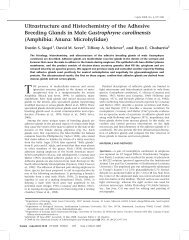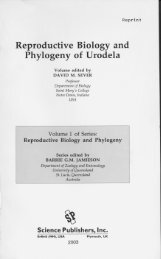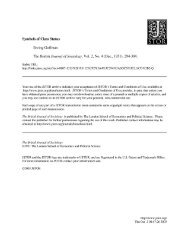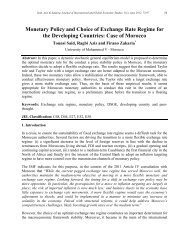Marvelous Facts and Miraculous Evidence in Early Modern Europe ...
Marvelous Facts and Miraculous Evidence in Early Modern Europe ...
Marvelous Facts and Miraculous Evidence in Early Modern Europe ...
Create successful ePaper yourself
Turn your PDF publications into a flip-book with our unique Google optimized e-Paper software.
124 Lorra<strong>in</strong>e Daston<br />
<strong>Facts</strong> <strong>and</strong> <strong>Evidence</strong><br />
the writ<strong>in</strong>gs of the natural theologians appealed to the desire for a calm<br />
religious life, free from nasty surprises <strong>and</strong> <strong>in</strong>spired upstarts.<br />
Scientific facts also became more regular <strong>and</strong> more commonplace,<br />
although the transition from bizarre s<strong>in</strong>gularities to mundane universals<br />
was a gradual <strong>and</strong> uneven one.99 However, even after scientific facts had<br />
been domesticated, the dist<strong>in</strong>ction between facts <strong>and</strong> evidence rema<strong>in</strong>ed<br />
part of the conceptual framework of natural science, often contested<br />
(start<strong>in</strong>g with Descartes <strong>and</strong> cont<strong>in</strong>u<strong>in</strong>g to the present day) but never completely<br />
extirpated. Long after scientific facts ceased to be the anomalies<br />
<strong>and</strong> exceptions Bacon used to destroy Aristotelian axioms <strong>and</strong> natural<br />
k<strong>in</strong>ds, they reta<strong>in</strong>ed their reputation for orner<strong>in</strong>ess. The portentous-signturned-scientific-fact<br />
left deeply etched traces <strong>in</strong> our way of th<strong>in</strong>k<strong>in</strong>g<br />
about evidence. In contrast, the contributions of the evidentiary miracle<br />
were not so long lived. Before worries first over demonic counterfeits <strong>and</strong><br />
later over human enthusiasm reduced miracles to rubber-stamp<strong>in</strong>g extant<br />
doctr<strong>in</strong>e, miracles seemed the purest form of evidence: their mean<strong>in</strong>g was<br />
patent to all who had eyes to see, <strong>and</strong> they compelled belief as irresistibly<br />
as a mathematical demonstration-<strong>in</strong>deed, more so, s<strong>in</strong>ce they required<br />
neither the tra<strong>in</strong><strong>in</strong>g nor the concentration of a mathematician. Miracles<br />
were God's privy seal <strong>and</strong> letters patent, certify<strong>in</strong>g a doctr<strong>in</strong>e as div<strong>in</strong>e<br />
<strong>and</strong> thereby conv<strong>in</strong>c<strong>in</strong>g onlookers of its truth. Ideally, miracles were transparent,<br />
requir<strong>in</strong>g no <strong>in</strong>terpretation, <strong>and</strong> were as satisfy<strong>in</strong>g to the senses<br />
<strong>and</strong> to the imag<strong>in</strong>ation as to reason.<br />
This dream of pure evidence evaporated with the division of evidence<br />
<strong>in</strong>to the <strong>in</strong>ternal evidence of th<strong>in</strong>gs <strong>and</strong> the external evidence of<br />
testimony, which division structured the debate over the evidencefor miracles.100<br />
The pure evidence of miracles, at least as conceived <strong>in</strong> the midseventeenth<br />
century, straddled the l<strong>in</strong>e between <strong>in</strong>ternal <strong>and</strong> external<br />
evidence: as sensible events miracles belonged to the realm of th<strong>in</strong>gs, but<br />
as supernatural events they also bore witness. They were the last form of<br />
evidence compatible with <strong>in</strong>tention, <strong>in</strong> this case div<strong>in</strong>e <strong>in</strong>tention, <strong>and</strong> it is<br />
ironic that suspicions of human <strong>in</strong>tention-that is, the <strong>in</strong>tent to feign<br />
miracles <strong>in</strong> order to usurp political <strong>and</strong> religious authority-ultimately<br />
deprived them of evidentiary value.<br />
99. On this transition, see Daston, "The Cold Light of <strong>Facts</strong> <strong>and</strong> the <strong>Facts</strong> of Cold<br />
Light: Lum<strong>in</strong>escence <strong>and</strong> the Transformation of the Scientific Fact 1600-1750," paper<br />
presented to the workshop on "The Technologies of Objectivity," University of California,<br />
Los Angeles, February 1990.<br />
100. On the early eighteenth-century debate <strong>in</strong> general, see Burns, The Great Debate on<br />
Miracles. On the role played by the dist<strong>in</strong>ction between <strong>in</strong>ternal <strong>and</strong> external evidence, see<br />
Daston, Classical Probability <strong>in</strong> the Enlightenment, pp. 323-30.







